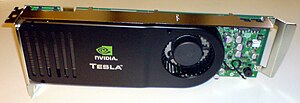Tesla (microarchitecture)
 |
|
| Fabrication process | 90 nm, 80 nm, 65 nm, and 55 nm |
|---|---|
| History | |
| Predecessor | G70 |
| Successor | Fermi |
Tesla is the codename for a GPU microarchitecture developed by Nvidia as the successor to their prior microarchitectures. Tesla is Nvidia's first microarchitecture to implement unified shaders. It was used with GeForce 8 Series, GeForce 9 Series, GeForce 100 Series, GeForce 200 Series, and GeForce 300 Series of GPUs manufactured in 90 nm, 80 nm, 65 nm, and 55 nm. It also found use in the GeForce 405, and in the workstation market in the Quadro FX, Quadro x000, Quadro NVS series, and Nvidia Tesla computing modules.
Tesla replaced the old fixed-pipeline microarchitectures, represented at the time of introduction by the GeForce 7 series. It competed directly with AMD's first unified shader microarchitecture named TeraScale, a development of ATI's work on the Xbox 360 which used a similar design. Tesla was followed by Fermi. The Tesla series takes its name from pioneering electrical engineer Nikola Tesla.
Tesla is Nvidia's first microarchitecture implementing the unified shader model. The driver supports Direct3D 10 Shader Model 4.0 / OpenGL 2.1(later drivers have OpenGL 3.3 support) architecture. The design is a major shift for NVIDIA in GPU functionality and capability, the most obvious change being the move from the separate functional units (pixel shaders, vertex shaders) within previous GPUs to a homogeneous collection of universal floating point processors (called "stream processors") that can perform a more universal set of tasks.
...
Wikipedia
